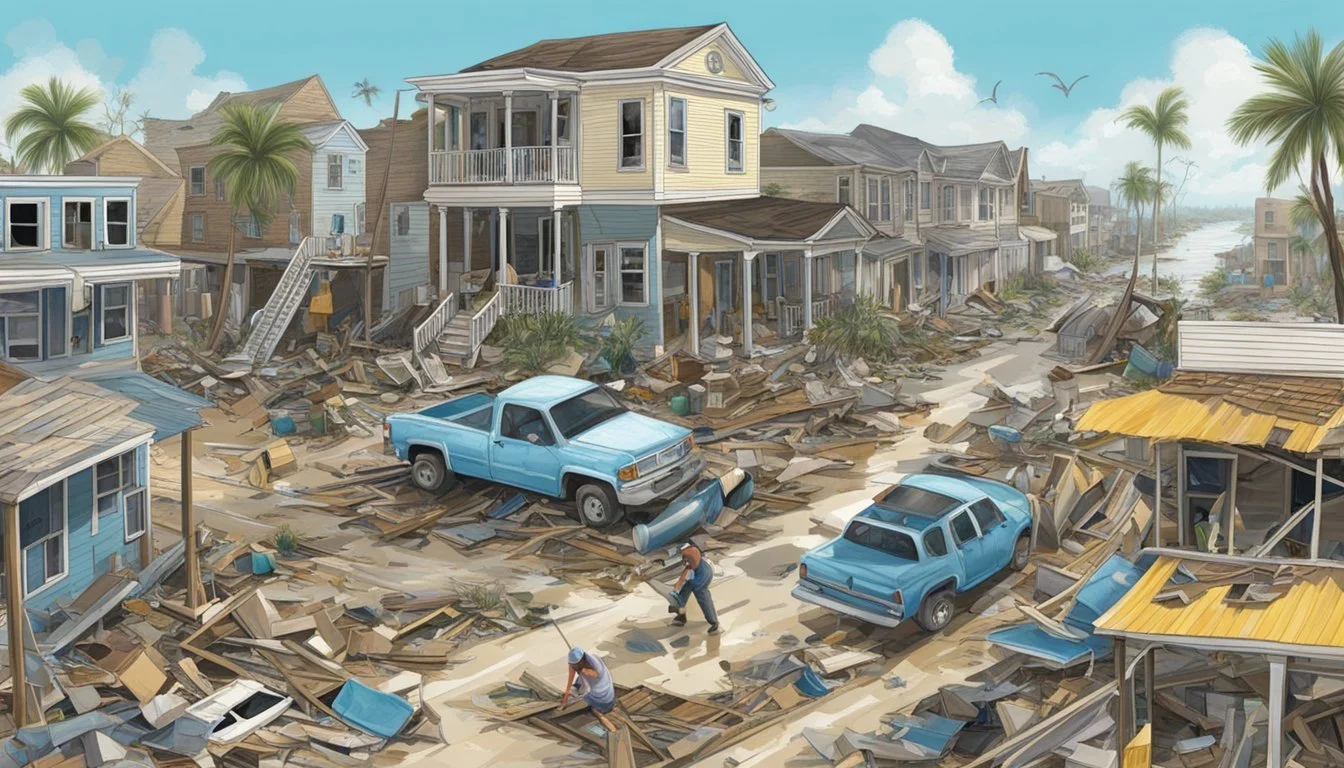5 Hurricane Rita Documentaries You Might Have Missed from 2005
Unveiling Overlooked Storm Stories
Hurricane Rita, a Category 5 storm that struck in 2005, left an indelible mark on the Gulf Coast. As part of the record-breaking 2005 Atlantic hurricane season, Rita became the fourth-most intense Atlantic hurricane ever recorded. The storm's impact on Texas and Louisiana was severe, resulting in significant damage and loss of life.
Several documentaries were produced to chronicle Hurricane Rita's destructive path and its aftermath, offering unique perspectives on this powerful natural disaster. These films provide valuable insights into the storm's formation, its effects on communities, and the subsequent recovery efforts. From news coverage to locally produced features, these documentaries serve as important historical records of Hurricane Rita's impact on the United States.
The 2005 hurricane season saw multiple Category 5 storms, with Rita often overshadowed by the more widely remembered Hurricane Katrina. However, Rita's intensity and the destruction it caused merit closer examination. These lesser-known documentaries offer viewers a chance to revisit this significant weather event and gain a deeper understanding of its place in hurricane history.
The Genesis of Hurricane Rita
Hurricane Rita began as a tropical wave and rapidly intensified into one of the strongest Atlantic hurricanes on record. Its development was marked by extreme pressure drops and wind speeds that surpassed many previous storms.
From Tropical Wave to Category 5
Rita originated from a tropical wave that moved off the African coast on September 7, 2005. It became a tropical depression on September 18 near the Turks and Caicos Islands. The system strengthened quickly, reaching tropical storm status just six hours later.
As Rita entered the warm waters of the Gulf of Mexico, it underwent explosive intensification. On September 21, it became a Category 5 hurricane with maximum sustained winds of 180 mph. This rapid strengthening occurred over a mere 24-hour period, showcasing the storm's remarkable development.
Rita's path through the Gulf posed a significant threat to coastal areas still reeling from Hurricane Katrina's impact just weeks earlier. The storm's size and strength prompted widespread evacuations along the Texas and Louisiana coasts.
Record-Breaking Storm Intensities and Pressure Readings
Rita set several records during its lifespan. It reached a minimum central pressure of 895 millibars, making it the fourth-most intense Atlantic hurricane ever recorded at the time. This low pressure contributed to Rita's extreme wind speeds and destructive potential.
The storm's rapid intensification was noteworthy. Rita's pressure dropped 69 millibars in just 24 hours, one of the fastest rates ever observed in the Atlantic basin. This dramatic strengthening caught many forecasters by surprise.
Rita maintained Category 5 status for about 18 hours. While it weakened before landfall, it remained a formidable Category 3 hurricane when it struck the Texas-Louisiana border on September 24. The storm's intensity and size resulted in significant storm surge and widespread damage across the region.
Path of Destruction
Hurricane Rita carved a devastating path through the Gulf of Mexico before making landfall on the Gulf Coast. The storm's intensity and size led to widespread damage across multiple states.
Through the Gulf: Affected Regions
Rita strengthened rapidly as it moved through the Gulf of Mexico. The hurricane's massive size affected a wide swath of the Gulf Coast. Strong winds and storm surge impacted coastal areas of Texas and Louisiana well before landfall.
Galveston Island and other parts of the Texas coast faced significant flooding from Rita's outer bands. Oil and gas production in the Gulf shut down, causing economic ripples across the region.
The Florida Keys experienced Rita's effects early on, with storm surge and heavy rains causing damage. As Rita approached land, its powerful winds extended up to 85 miles from the center.
Landfall on the Gulf Coast: Local Impact
Rita made landfall between Sabine Pass, Texas and Johnson's Bayou, Louisiana on September 24, 2005. The storm brought intense winds, torrential rain, and a destructive storm surge to southwestern Louisiana and southeastern Texas.
Cameron Parish, Louisiana bore the brunt of Rita's fury. The area saw catastrophic damage, with many structures completely destroyed. Storm surge reached up to 15 feet in some locations.
In Texas, Beaumont, Port Arthur, and Orange suffered severe flooding and wind damage. Hundreds of thousands lost power across both states. Inland areas faced tornado threats and heavy rainfall as Rita moved north.
The storm's impact extended beyond the immediate coastal areas, causing widespread evacuations and long-term disruptions to daily life in the region.
Impact and Aftermath
Hurricane Rita's landfall on September 24, 2005 brought widespread destruction to the Texas-Louisiana border region. The storm's effects were felt across a large area, causing significant damage to infrastructure and communities.
Assessing the Damage
Rita's powerful winds and storm surge devastated coastal areas. Homes and businesses were destroyed or severely damaged along the Louisiana coast and in parts of southeastern Texas. The hurricane's impact extended inland, with flooding and wind damage reported in multiple counties.
Many roads became impassable due to debris and floodwaters. Power outages affected millions of residents, some lasting for weeks. Oil and gas production in the Gulf of Mexico was disrupted, leading to temporary fuel shortages.
Human and Economic Toll
Rita caused over 100 fatalities, with many occurring during the chaotic evacuation of Houston and surrounding areas. Over 3 million people fled the storm's path, creating one of the largest traffic jams in U.S. history.
The economic impact was severe. Estimates placed total damages at $18.5 billion, making Rita one of the costliest hurricanes on record. Insurance claims exceeded $10 billion.
Recovery efforts were complicated by the recent devastation of Hurricane Katrina. Resources were stretched thin as communities in Texas and Louisiana worked to rebuild homes, restore power, and revive local economies.
Hurricane Rita in Images and Audiovisuals
Hurricane Rita's intensity and impact were captured through striking visuals and powerful audio recordings. These media elements provide a vivid record of the 2005 storm.
Capturing Rita: Photography and Video
NASA satellites produced remarkable images of Hurricane Rita at its peak strength. On September 21, 2005, the Terra satellite's MODIS instrument captured a clear view of Rita's compact, circular structure and open eye. This image revealed the deep blue Gulf waters visible through the storm's center.
Video footage documented Rita's approach and aftermath. News crews and storm chasers recorded the hurricane's fierce winds and storm surge as it made landfall. Aerial video surveys showed extensive flooding and damage in coastal areas of Texas and Louisiana.
Time-lapse satellite imagery tracked Rita's rapid intensification into a Category 5 hurricane. These sequences illustrated the storm's organization and eye formation over warm Gulf waters.
Audio and Sound Bites of the Storm
Audio recordings captured the raw power of Hurricane Rita. Weather stations and storm chasers documented the increasing winds as Rita approached land. The howling gusts and pelting rain created an ominous soundtrack.
Radio broadcasts preserved real-time updates and warnings as Rita neared the coast. Emergency officials' announcements and eyewitness reports provided critical information to residents in the storm's path.
Interviews with survivors and first responders offered personal accounts of Rita's impact. These sound bites conveyed the fear, determination, and resilience of those who experienced the hurricane firsthand.
Response and Preparedness Measures
Government agencies and local authorities took swift action to prepare for Hurricane Rita's impact. Evacuation efforts were implemented to move residents out of harm's way, while shelters were set up to accommodate those unable to leave.
Government and Local Authority Actions
Officials mobilized resources in anticipation of Hurricane Rita. The Texas National Guard was activated to assist with emergency operations. Rapid-response teams were stationed in San Antonio and Fort Worth, along with 78 tractor-trailer rigs of ice and water.
Search and rescue teams were readied for deployment. Disaster medical teams were prepared to provide emergency care. The White House established a task force to coordinate the federal response.
State and local authorities implemented emergency management plans. They focused on securing critical infrastructure and positioning supplies for post-storm recovery efforts.
Evacuations and Shelter Efforts
A mandatory evacuation order was issued for coastal areas in Texas. Officials encouraged residents to leave early to avoid traffic congestion. Contraflow lanes were implemented on major highways to facilitate the exodus.
Shelters were opened inland to accommodate evacuees. Red Cross and other organizations prepared supplies and staffing for these facilities. Special arrangements were made for elderly and disabled individuals who required assistance.
Gas stations along evacuation routes were stocked to prevent fuel shortages. Public transportation was utilized to help those without personal vehicles. Some residents chose to shelter in place, stocking up on essential supplies.
Scientific Analysis and Records
Hurricane Rita's scientific analysis yielded crucial data on storm intensity and tracking. Meteorologists and space agencies employed advanced technologies to study this powerful hurricane.
Meteorological Assessments by NHC and NASA
The National Hurricane Center closely monitored Rita's development. They classified it as a Category 5 hurricane on the Saffir-Simpson Hurricane Wind Scale. Rita's central pressure dropped to 895 millibars, making it the fourth most intense Atlantic hurricane on record at the time.
NASA's Goddard Space Flight Center utilized satellite imagery to track Rita's path and structure. Their data revealed Rita's massive size, with hurricane-force winds extending up to 85 miles from the center.
Researchers compared Rita's intensity to Hurricane Katrina, which had struck just weeks earlier. This analysis helped improve understanding of rapid intensification processes in major hurricanes.
Technological Advances in Tracking
Improved radar imagery allowed for more accurate predictions of Rita's landfall location. The National Weather Service deployed mobile Doppler radar units to capture high-resolution data of the hurricane's inner core.
Satellite technology advancements provided real-time updates on Rita's wind speeds and cloud temperatures. This information proved crucial for evacuation planning and emergency response efforts.
Scientists used hurricane hunter aircraft to gather data from inside the storm. These missions collected valuable information on Rita's internal structure and wind patterns, enhancing forecast accuracy.
Legacy and Cultural References
Hurricane Rita left a lasting impact on popular culture and education. Its effects continue to be explored through various media and educational initiatives.
Hurricane Rita in Popular Media
Several documentaries and films have depicted Hurricane Rita's devastation. KPLC, a local news station in Lake Charles, Louisiana, created a documentary highlighting the before, during, and aftermath of the storm. This production provided a firsthand account of Rita's impact on southwest Louisiana.
News coverage of Hurricane Rita was extensive, with NPR reporter Phillip Davis offering unique insights from inside the storm. He accompanied hurricane hunters from NOAA, providing listeners with a rare perspective on the hurricane's intensity.
Educational and Cultural Impacts
The Hurricane Digital Memory Bank, organized by the Roy Rosenzweig Center for History and New Media and the University of New Orleans, preserves the collective memory of Hurricanes Katrina and Rita. This free public archive contains countless stories, images, and artifacts related to Rita.
The storm's legacy extends to scientific research and education. Meteorologists and climate scientists continue to study Rita's rapid intensification and path, using this knowledge to improve hurricane forecasting models.
Rita's impact on Gulf Coast communities has inspired art exhibitions, memorial events, and local history projects. These cultural initiatives help preserve the storm's memory and educate future generations about its significance.
Archival Resources and Further Research
Several digital archives and scientific databases provide extensive documentation on Hurricane Rita. These resources offer valuable insights for researchers and those interested in learning more about this historic storm.
Researching Rita: Libraries and Digital Archives
The Hurricane Digital Memory Bank hosts a vast collection of Rita-related materials. This free public archive contains photos, videos, and personal accounts from those affected by the hurricane. The Wayback Machine also preserves numerous web pages from 2005, offering a glimpse into real-time coverage and public reactions.
Local libraries in affected areas often maintain special collections focused on Rita. These may include newspaper clippings, damage reports, and oral histories from survivors.
Scientific Literature and Documentation
The National Climatic Data Center offers comprehensive meteorological data on Rita's formation and progression. Researchers can access detailed reports, satellite imagery, and storm track information.
HURDAT (Hurricane Database) and IBTrACS (International Best Track Archive for Climate Stewardship) provide standardized datasets on Rita's intensity and path. These resources are invaluable for climatologists studying long-term hurricane trends.
Scientific journals contain peer-reviewed studies on Rita's impacts, including storm surge modeling and ecological consequences. Many of these papers are available through university libraries or online databases.




